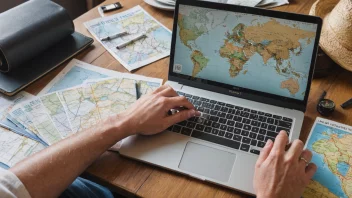Introduction
Solo travel offers unique experiences that can deeply enrich your life. Writing about your adventures can help you process your experiences and share your journey with others. In this article, you will learn how to effectively capture the essence of solo travel in your writing through structured steps that enhance both your storytelling and personal reflection.
Step 1: Choose Your Medium
The first step in capturing your solo travel experiences is to decide how you want to document them. Here are some options:
- Blogging: Create a travel blog to share your stories with a wider audience.
- Journaling: Keep a personal journal to reflect on your daily experiences.
- Social Media: Use platforms like Instagram or Twitter for short, impactful updates.
- Photography: Combine your writing with photography to enrich your narrative.
Step 2: Be Observant
As you travel alone, take the time to observe your surroundings. Here’s how:
- Engage Your Senses: Pay attention to sights, sounds, smells, and feelings. This will help you create vivid descriptions.
- Interact with Locals: Ask questions and learn about the culture. This adds depth to your experiences.
- Document Your Thoughts: Keep a small notebook handy to jot down observations and thoughts as they come to you.
Step 3: Find Your Voice
Your writing style should reflect your personality. Consider these tips:
- Be Authentic: Write in a way that feels natural to you. Don’t try to mimic others.
- Use Humor: If appropriate, allow your sense of humor to shine through in your writing.
- Be Honest: Share both the highs and lows of your journey. Authenticity resonates with readers.
Step 4: Create a Narrative Structure
A well-structured narrative can captivate your audience. Here’s how to create one:
- Start with a Hook: Grab the reader’s attention with an interesting opening line or question.
- Develop a Theme: Identify a central theme that ties your experiences together, such as self-discovery or adventure.
- Use a Clear Timeline: Organize your writing chronologically or thematically for clarity.
Step 5: Include Personal Reflections
Sharing your thoughts and feelings adds richness to your writing. Consider the following:
- Reflect on Changes: How have your experiences transformed you?
- Write About Challenges: What obstacles did you face, and how did you overcome them?
- Explore Emotions: Dive into your emotional responses during your travels.
Step 6: Edit and Revise
Editing is crucial for polishing your writing. Here are some tips:
- Take a Break: Step away from your writing for a day or two before revising.
- Read Aloud: Hearing your words can help you identify awkward phrasing.
- Seek Feedback: Share your writing with trusted friends or fellow travelers for constructive criticism.
Step 7: Share Your Work
Once you’re satisfied with your writing, it’s time to share it:
- Publish on Your Blog: Share your post and promote it on social media.
- Join Writing Communities: Participate in travel writing forums or groups to connect with like-minded individuals.
- Submit to Travel Publications: Consider submitting your pieces to magazines or websites that focus on travel.
Conclusion
Capturing the essence of solo travel in writing is a rewarding endeavor. By following these steps - choosing your medium, being observant, finding your voice, creating a narrative structure, including personal reflections, editing your work, and sharing it - you can create compelling stories that resonate with readers. Remember that your unique perspective is valuable, and your stories can inspire others to embark on their own adventures.






